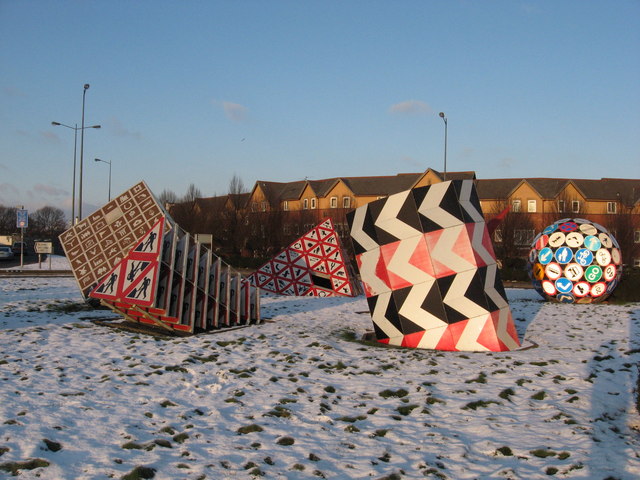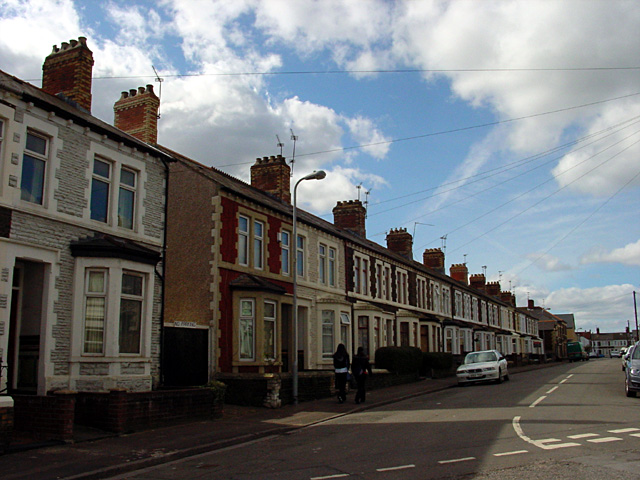
Some like it Splott

With a great location, sense of community and affordable housing, Splott is a perfect choice for first-time buyers. CPS Homes explores the changing fortunes of an iconic Cardiff district.
No other area of Cardiff – or many other British cities for that matter – has garnered as much national recognition, amusement and affection purely for its name. Splott is one you remember.
"The word Splott itself doesn't sound exactly beautiful – which may be why it was described to me as 'upper Bay' when I looking to buy here – but I like the fact that it sounds semi-comical, it reminds me of the splat guns in Buggsy Malone," says Chris Hayden, an insurance claims manager who moved to Splott as a first-time buyer 11 years ago.
As evocative and full of character as the place it describes, Splott, or Y Sblot in Welsh, takes its name from Old English for a patch of land, though some would have you believe it is derived from ‘God’s Plot’, it once having belonged to the Bishop of Llandaff.
While some might denounce it as more blighted than blessed, thousands of us know better.
"When I hear the name Splott it conjures up memories of old Cardiff streets, my lovely next-door neighbours and Chelsea buns from Brutons Bakery on Clare Road," says Gaby Jones, whose first house purchase was in Adeline Street.
Chris Hayden holds similar affection for the place. “Splott is so much better than it sounds,” he says. “I love living here. It isn’t as young and vibrant as say Roath, Pontcanna or the Bay, but I kind of like that. It feels like Cardiff as I remember it, and I like the diversity of the people that live here.”
RISE AND FALL
Now home to the Magic Roundabout, its famous eponymous market, an endangered swimming pool (how many of us learned to swim here?), and more than 13,000 Cardiffians, Splott was until the late 19th century farmland belonging to Upper and Lower Splott Farms, part of the Tredegar Estate.
Its swift transition in the 1880s into an impoverished working class community in a network of tightly-packed Victorian housing echoed the nearby expansion of Cardiff’s iron and steel industry which was hungry for workers.
Dowlais Steelworks moved to Cardiff and opened East Moors Steelworks in next door Tremorfa in 1891. After significant growth in the first part of the 20th century – by the 1930s the plant was capable of producing half a million tons of steel a year – the middle of the century saw a long, drawn-out decline for industry in Cardiff. The closure in 1978 of East Moors Steelworks saw thousands of job losses, but an end to hung-out-to-dry washing turning red from pollution.
CHANGE AND CONTINUITY
Parts of Splott have been transformed beyond recognition. In the 1970s, 17 streets of homes were demolished, including streets Enid, Layard, and Menelaus. The successful football club Bridgend Street AFC, founded in 1899, is a reminder of another vanished Splott street, once full of homes, families and memories.
“I grew up in Splott, attending St Albans then Splott Road High,” remembers Joe Rocco Federico. “My dad had a hardware shop in Carlisle Street opposite Orsolini’s the grocer. In 1970 we moved to Llanishen. In 1974 we moved back to Splott, but boy how it had changed in that time.”
In more recent years, while other areas of Cardiff have seen significant growth or gentrification, changes in Splott have perhaps been a little more subtle.
“Splott has changed both little and a lot over the years,” suggests Simon Nurse, a cycling enthusiast, blogger and employee at Odoni Elwell, a cycle storage fabricators based on the edge of Splott.
“The area is recognisably Splott: rows of Victorian houses and quiet urban bustle, the distant sound of trains, a sense of being in the heart of the Welsh capital. Yet the area has also modernised (albeit slowly) with old hotels turned into prime housing and the gradual movement of professional people into the area.”
COMMUNITY AND HERITAGE

As hard as life was for Splott’s inhabitants in the past, there were few places with as strong a sense of community. Churches of various faiths, and social and sports clubs abounded. It seems this vibrancy and camaraderie is held in deep affection by almost everyone who has ever lived here.
“Splott means so much in so many ways,” says Salvatore Amodeo, who first knew it as a 13-year-old Italian immigrant in the early 1960s. “It was my first home in this country, in the shadow of the smoky and gritty steelworks. It was a real community, full of hardworking people. I will never forget the friendly welcome and the ease with which one made friends. It will always be one of my spiritual homes.”
The sense of community remains to this day. “There seems to be a good representation of older people and families here,” says resident Chris Hayden. “This helps give it a sense of community and heritage.”
This sentiment is echoed by Simon Nurse. “Splott is central, grounded and earthy,” he says. “Unlike some of the newer sections of the city, Splott has personality. It’s a place where people know their neighbours and there's a real sense of community – from the smiling teller at the Nat West Bank on Splott Road, to the ladies at Bruton's bakery on Carlisle Street who used to tuck away Welsh cakes for my lunch time treat.”
CENTRAL PERKS
Splott offers those wanting to live close to Cardiff city centre an excellent opportunity. It’s but a 25 minute work to town or the bay, while Newport Road’s barn-like stores are just across the tracks.
Sally Pritchard, a local government data consultant, bought her first house in Railway Street in 2003. “A two-bed terrace with two reception rooms and plenty of space for a twenty-something, it was the second house the estate agent showed me and as soon as I saw it I knew it was ‘the one’,” she recalls.
Sally also considers prices and housing quality as significant attractions. “It needed no work at all and was much cheaper than similar properties in other areas of Cardiff,” she says. “I’ll always remember that when I had Sky installed, the engineer had to drill a hole through the wall of the front of my house. It took him hours. He said, ‘They don’t build houses like these in Splott anymore.’”
When after five years Sally decided to move on, her house was snapped up within a week. “I believe because the houses in Splott keep their value and are always going to be in demand for first-time buyers and young families,” she says.
SPLOTT PARTY
“I will always remember my time in Splott fondly as it’s a brilliant place to live,” says Sally. “We’d be welcomed into random people’s houses on my street at 3am for drinks and dancing after a night out.”
It may not be fashionable or ‘on-trend’ (yet) by comparison to some areas of Cardiff, but for community spirit, a sense of place, convenience, and the odd impromptu house party, Splott is hard to beat.
Not a Splott of people know that...
- Splott’s first school was Splottlands, opened in 1882, on the site of where the STAR Centre is now. The STAR Centre name stands for Splott, Tremorfa, Adamsdown and Roath. Lennox Lewis trained here before his 1993 fight against Frank Bruno.
- In the early 20th century Splott University Settlement was one the most successful British baseball teams, winning the Welsh League title several times.
- Journalist and TV and radio presenter John Humphrys was born in Splott, in 1943.
- Torchwood and Dr Who have been filmed in Splott.
- Splott-born and bred director and playwright Peter Gill has written plays about the place.
- Dame Shirley Bassey went to Moorland Road School when her family moved to Portmanmoor Road.
The information contained within this article was correct at the date of publishing and is not guaranteed to remain correct in the present day.


